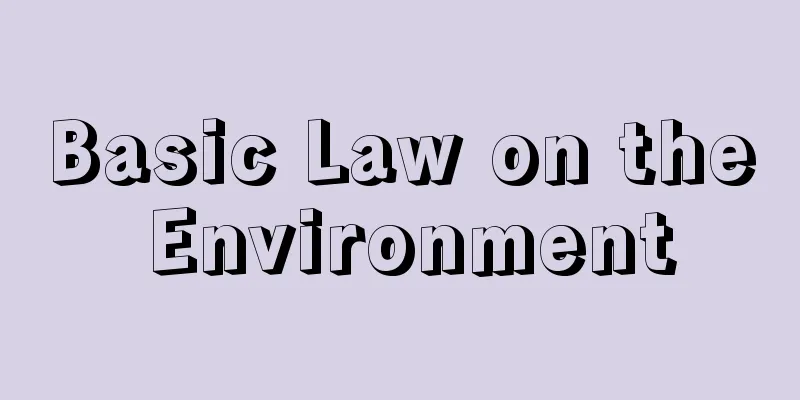Basic Law on the Environment

|
This law was promulgated and put into effect on November 19, 1993, in order to set out basic principles for environmental conservation, clarify the responsibilities of the national and local governments, businesses, and citizens, and to set out the basic matters for environmental conservation policies (the Basic Law for Environmental Pollution Control was abolished when this law came into effect). Law No. 91 of 1993. It is a new basic law that indicates the basic direction of Japan's environmental policy, including global environmental conservation. The Act first sets out as its basic principles the enabling of present and future generations of people to enjoy the benefits of a healthy and bountiful environment (Article 3), the aim of which is to create a society capable of sustainable development with minimal environmental impact (Article 4), and the active promotion of global environmental conservation through international cooperation (Article 5). It then stipulates the responsibilities of the State, local governments, business operators, and citizens (Articles 6 to 9), and stipulates that the following policies should be established as basic measures for environmental conservation. The first is the Basic Environment Plan (Article 15). This is a basic plan for the comprehensive and systematic promotion of environmental conservation policies, and is decided by cabinet decision. The plan was established in 1994. The second is environmental consideration in national policies (Article 19) and the environmental impact assessment system (environmental assessment) (Article 20). The environmental assessment system was enacted into law in June 1997 and came into effect in June 1999. However, the assessment system under this law is limited to project assessments, and the next issue is to enact a system of plan assessment or strategic assessment (based on Article 19). The third is economic measures to prevent impediments to environmental conservation (economic support such as environmental taxes and subsidies) (Article 22), but while there are various types of economic support, there is still no prospect of introducing an environmental tax, which aims to reduce actions that cause a large burden on the environment by imposing economic burdens.In addition, with regard to policies concerning pollution control, this law inherits the policies stipulated in the Basic Law for Environmental Pollution Control (environmental standards, pollution prevention plans, settlement of pollution disputes and relief for damage, etc.). [Takahisa Awaji] "Masuhara Yoshitake, Illustrated Guide to the Basic Environment Law (1994, Chuohoki Publishing)" ▽ "Environment Agency Planning and Coordination Bureau, Commentary on the Basic Environment Law (1994, Gyosei)" ▽ "Global Environmental Issues Discussion Group, What is the Basic Environment Law? Eliminate Pollution, Protect the Global Environment!" (1993, Godo Publishing)" ▽ "National Liaison Conference of Minamata Disease Victims and Lawyers, Complete History of the Minamata Disease Trials, Vol. 1 General Discussion, Vol. 2 Responsibility (1998, 1999, Nippon Hyoronsha)" [Reference items] | | | | | |Source: Shogakukan Encyclopedia Nipponica About Encyclopedia Nipponica Information | Legend |
|
環境の保全について、基本理念を定め、国、地方公共団体、事業者および国民の責務を明らかにするとともに、環境保全に関する施策の基本となる事項を定めるため1993年11月19日に公布、施行された法律(同法の施行によって公害対策基本法は廃止された)。平成5年法律91号。地球環境保全を含めて、わが国の環境政策の基本的方向を示す新たな基本法である。 同法は、まず、基本理念として、現在および将来の世代の人間が健全で恵み豊かな環境の恵沢(けいたく)を享受できるようにすること(3条)、環境への負荷の少ない持続的発展の可能な社会が構築されることを旨とすること(4条)、および国際的協調の下に地球環境保全を積極的に推進すること(5条)を掲げ、ついで、国の責務、地方公共団体の責務、事業者の責務および国民の責務を規定(6条から9条)したのちに、環境保全のための基本的施策として次のような施策を定めるべきものとした。 すなわち、第一は、環境基本計画である(15条)。これは、環境の保全に関する施策の総合的かつ計画的な推進を図るための基本計画であって、閣議決定によって決められる。同計画は1994年(平成6)に策定された。 第二は、国の施策にあたっての環境配慮(19条)および環境影響評価制度(環境アセスメント)である(20条)。環境アセスメント制度は、1997年6月に法制化され、99年6月に施行された。ただし、同法によるアセスメント制度は事業アセスメントにとどまっており、計画アセスメントあるいは戦略的アセスメント制度の法制化(19条に基礎づけられる)が次の課題となっている。 第三は、環境保全上の支障を防止するための経済的措置(環境税などの負担や補助金などの経済的支援)である(22条)が、経済的支援にはいろいろあるものの、経済的負担をかけることによって環境に大きな負荷をもたらす行為を減らしていこうとする環境税のほうは、いまだ導入の見込みがたっていない。このほか、同法は公害対策に関する施策については、公害対策基本法で定められた施策(環境基準、公害防止計画、公害紛争の処理および被害の救済など)を受け継いでいる。 [淡路剛久] 『増原義剛著『図でみる環境基本法』(1994・中央法規出版)』▽『環境庁企画調整局編著『環境基本法の解説』(1994・ぎょうせい)』▽『地球環境問題懇談会編『環境基本法ってなあに――なくせ公害・守ろう地球環境!』(1993・合同出版)』▽『水俣病被害者・弁護団全国連絡会議編『水俣病裁判全史』第1巻総論編、第2巻責任編(1998、99・日本評論社)』 [参照項目] | | | | | |出典 小学館 日本大百科全書(ニッポニカ)日本大百科全書(ニッポニカ)について 情報 | 凡例 |
<<: Environmental art (English spelling)
Recommend
Relief - Ukibori
A sculptural technique in which an image is raised...
abyssal
In marine biology, the deep sea refers to a depth...
Shingaku Hayasomegusa - Shingaku Hayasomegusa
Yellow cover. Written by Santo Kyoden. Illustrated...
Modern Danish - Kindaidenmarkgo
…It is the official language of the Kingdom of De...
International Judo Federation
… Judo enthusiasm overseas also flourished after ...
Molipteryx fuliginosa (English name) Molipteryxfuliginosa
...The original species is common in Europe, and ...
Heirinji Temple
This temple is of the Rinzai sect of Buddhism, My...
Noordhollands Kanaal (English spelling)
...It is 15.5m deep and 170m wide, and can handle...
Mon language - Mongo (English spelling)
Also called Thalaing. A language found in the east...
Iconography
Iconography (→ Buddhist iconography). Works of art...
Vertical photography
...Also, the area covered by one frame is large, ...
Hanawa basin - Hanawabonchi
A graben basin in the upper reaches of the Yonesh...
Plumeria alba (English spelling) Plumeria alba
…[Kazuo Furusato]. … *Some of the terminology tha...
Susumu Odagiri
1924-1992 A literary critic from the late Showa t...
Scrofula - Ruireki
A common name for tuberculous cervical lymphadenit...









